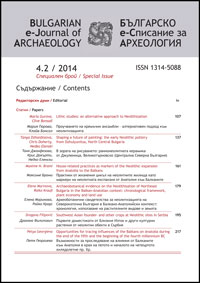House-related practices as markers of the Neolithic expansion from Anatolia to the Balkans
House-related practices as markers of the Neolithic expansion from Anatolia to the Balkans
Author(s): Maxime BramiSubject(s): Archaeology
Published by: Асоциация на българските археолози
Summary/Abstract: Following the assumption that the Neolithic witnessed the first widespread appearance of permanent houses and households, in line with the adoption of sedentism, this article examines the relevance of residential and construction practices to our understanding of the process of Neolithic expansion from Anatolia to the Balkans. Three practices, with a broad spatial distribution, are reviewed: house burning, the vertical superimposition of houses and intra-settlement burial. The article first outlines the basis of a contextual method to retrieve practices from material patterning left in the record, such as burnt houses for the practice of intentional house burning. The next section delves into the similarities in practices between Neolithic communities in Anatolia, Thrace and Greece, during the 7th and 6th millennia BC cal. to suggest that: 1) house burning was a key strategy to bring houses to ‘closure’ at the end of their use-lives; 2) people took advantage of the stability of extant houses to build new houses atop; and 3) this practice was closely connected with the burial of the dead in, or in close proximity to, houses. Common attitudes to residence and construction across a vast array of sites underpin similarities in house form and house use patterns. To conclude, the discussion highlights the need for a dynamic approach, based on comparative time-lines of practices, to determine the direction of spread.
Journal: Българско е-Списание за Археология
- Issue Year: 4/2014
- Issue No: 2
- Page Range: 161-177
- Page Count: 17
- Language: English

